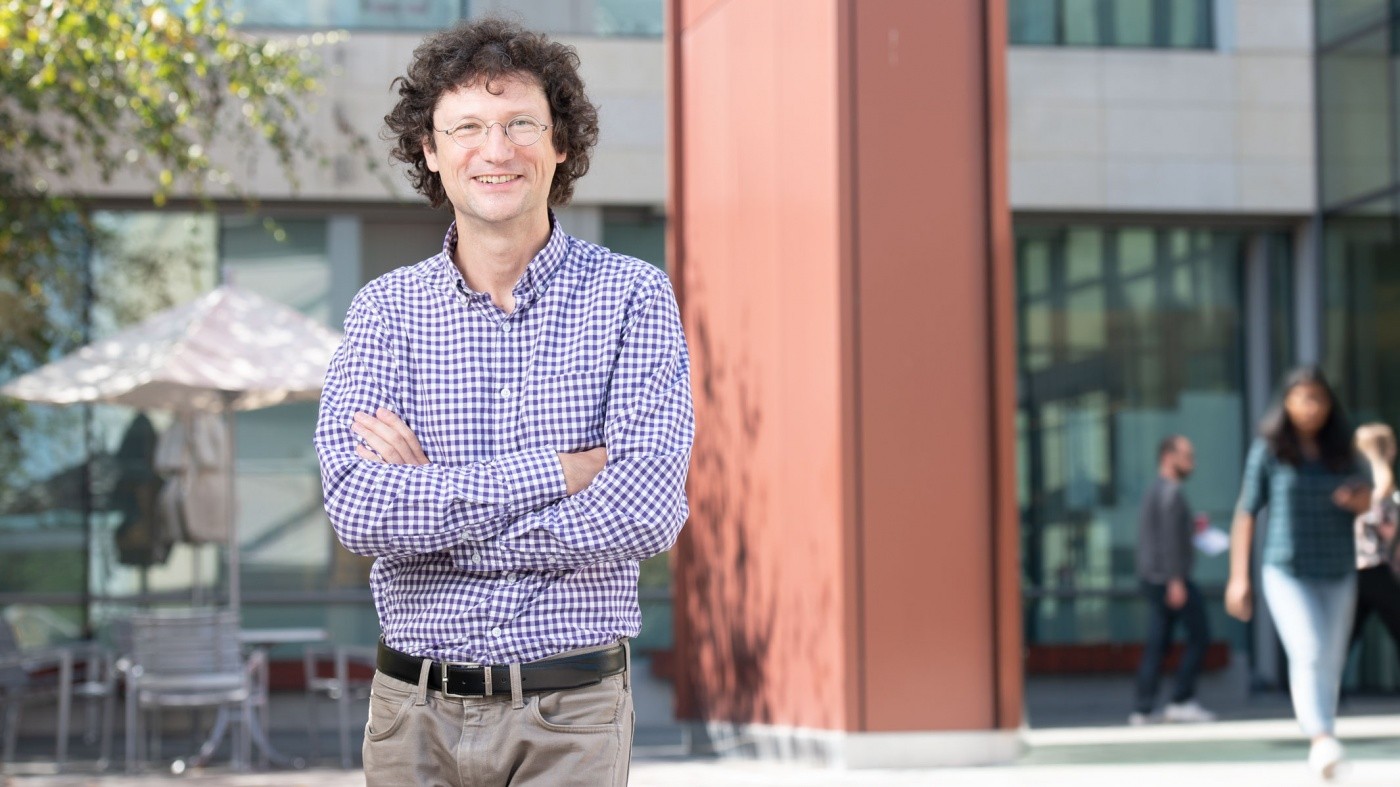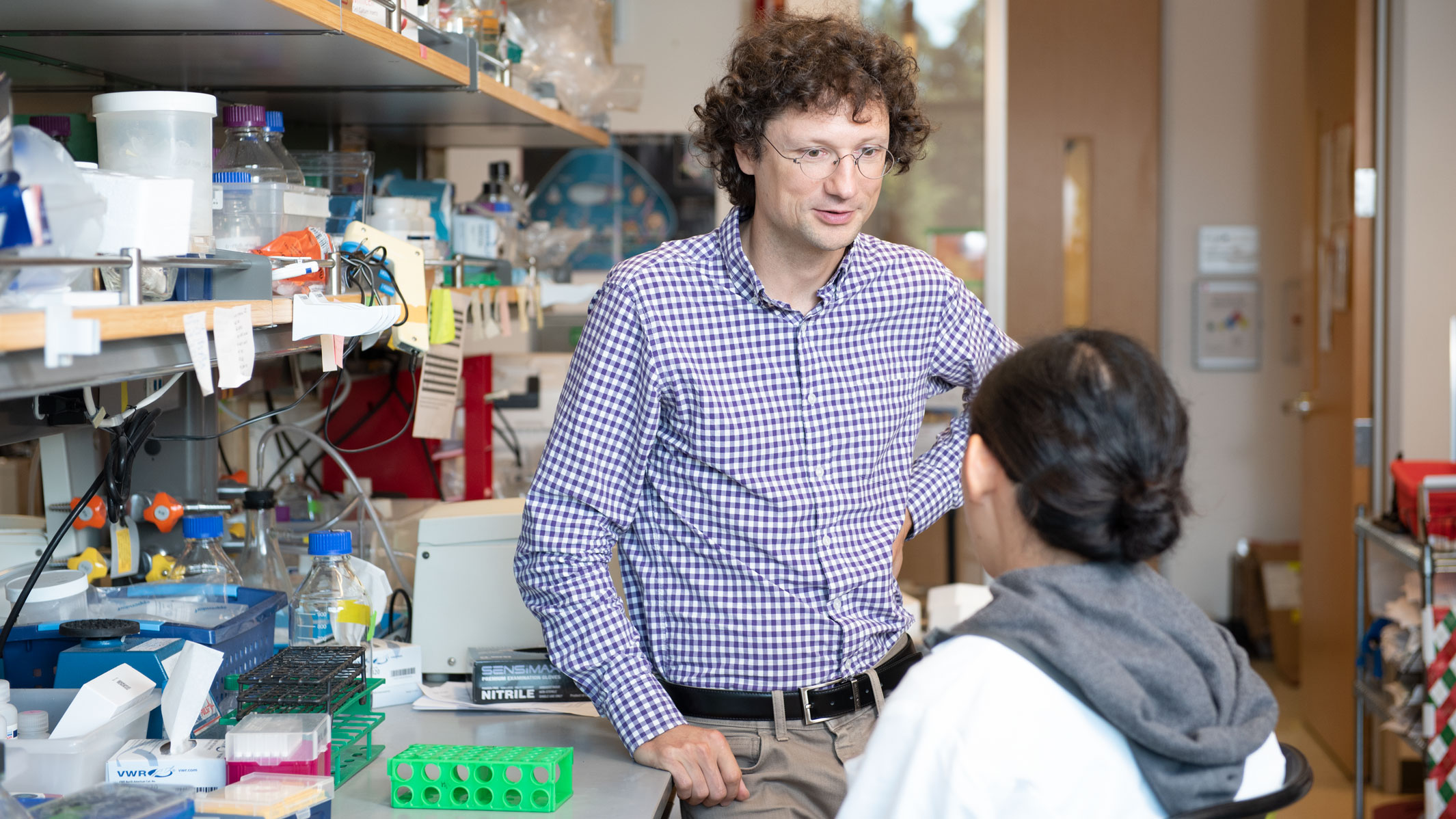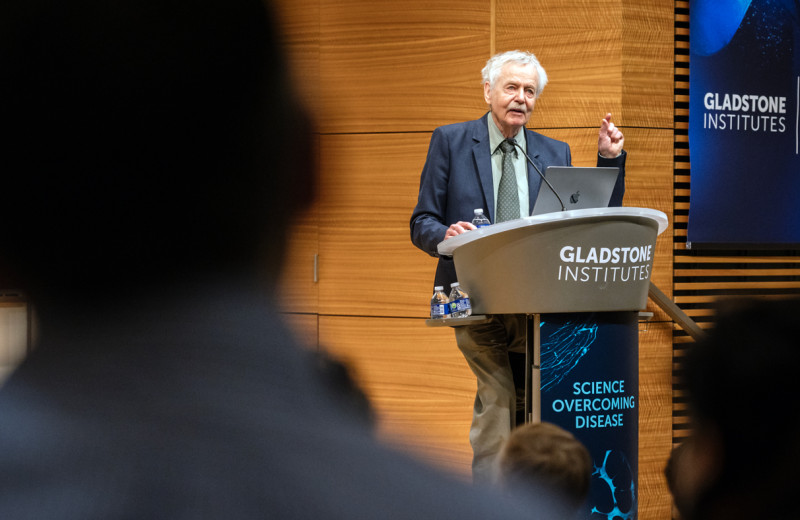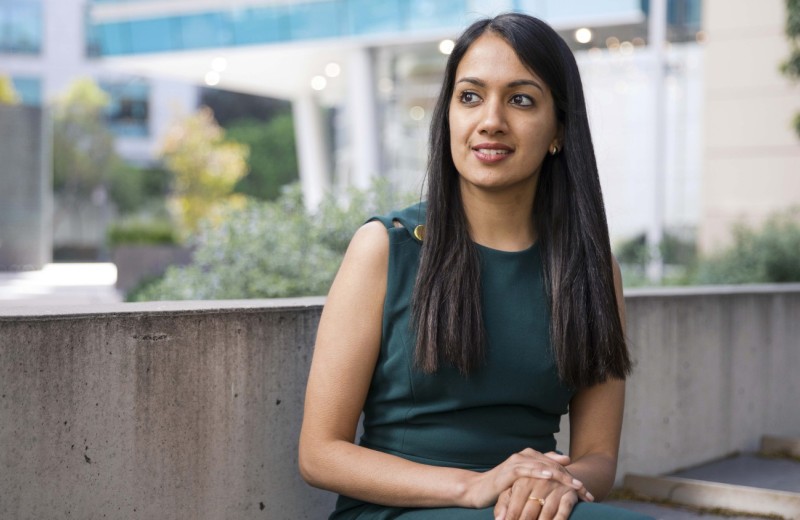Gladstone NOW: The Campaign Join Us on the Journey✕

Winner of the 2018 Ogawa-Yamanaka Stem Cell Prize, Marius Wernig is striving to turn his vision of regenerative medicine into reality.
Marius Wernig, MD, PhD, was awarded the 2018 Ogawa-Yamanaka Stem Cell Prize for his groundbreaking research in cellular reprogramming and stem cell–based therapies for genetic disease. He is an associate professor of pathology at the Institute for Stem Cell Biology and Regenerative Medicine at Stanford University, and a faculty scholar with the Howard Hughes Medical Institute.
A self-proclaimed nerd, he describes what it was like to be part of the action that led to the explosion of stem cell research. He also discusses his fascination with the power of cells and his vision for the future of regenerative medicine.
Imagine going to visit your doctor, and instead of prescribing a pill, she gives you human-engineered cells intended to go into your body, analyze the problem, and respond accordingly. This may sound like science fiction to most, but it’s the future Marius Wernig envisions.
He has devoted his career to studying how to harness the power of stem cells and helped propel forward the field of direct reprograming, which involves transforming one type of adult cell directly into another—in this case, into brain cells called neurons.
Wernig is also finding ways to use reprogrammed cells for transplantation-based therapies. He is currently developing a new treatment that could help infants and young children who suffer from a devastating skin disease called epidermolysis bullosa.
“You can be as excited to conduct very basic research with few disease implications, as you can be for research that could directly benefit people,” said Wernig. “I’m very curious about how biology works and want to contribute to our common knowledge. But it’s also very important to me that my work could eventually make the world better and help improve patients’ lives.”
Since the beginning of his career, Wernig’s trailblazing studies have fueled science around the globe. That’s why he was selected as the 2018 recipient of the Ogawa-Yamanaka Stem Cell Prize.
“Marius’s work has had a tremendous impact on basic science and influenced the way scientists in many fields use stem cells,” said Deepak Srivastava, MD, president of Gladstone Institutes and member of the prize’s selection committee. “We also chose Marius to recognize his remarkable efforts to translate his findings to the clinic.”
The prize supports scientists who are using cellular reprogramming to advance regenerative medicine. It is named, in part, after Gladstone Senior Investigator and Nobel laureate Shinya Yamanaka, MD, PhD, in honor of his invention of induced pluripotent stem cells (iPSCs), which altered the landscape of stem cell biology. Yamanaka discovered how to reprogram adult skin cells so they can function like embryonic stem cells and, in turn, be converted into any type of cell in the body.
“I’m deeply moved to receive this prestigious award carrying Shinya Yamanaka’s name, the father of the field,” said Wernig. “This is one of the most wonderful moments in the life of a scientist, to be recognized by your colleagues in such an amazing way and realize that your work is meaningful to them.”
The award was established in 2015 by the late Hiro Ogawa, as a way to continue the philanthropic legacy he shared with his wife Betty during their 46-year marriage.
“Betty and Hiro Ogawa truly were visionary,” shared Wernig. “Although they had no basic training in biology or medicine, they recognized the potential of our then-nascent field of cellular reprogramming, and the truly groundbreaking developments yet to come.”
“Marius is the youngest recipient of this prize to date,” said Hiro and Betty’s son, Andrew Ogawa, during the award ceremony. “I’m glad he’s this year’s recipient because my father always wanted to support young, ambitious leaders.”
From Reprogramming Cells to Healing Wounds
Early in his career, Wernig was already paving the way for his colleagues.
As a postdoctoral fellow, he showed that rodent models of Parkinson’s disease could be treated using iPSCs. This was one of the first indications to the scientific community that iPSC technology could potentially be used for clinical applications.
Today, his laboratory focuses on the fundamental question of cell identity. All the cells in your body—skin cells, brain cells, heart cells, liver cells—have the exact same genome. Yet, they look and function very differently. Wernig’s team is trying to understand the mechanisms that determine these different identities. They want to learn how to better reprogram one cell type into another, and then use the cells they generate to understand how diseases work.
Of his numerous studies, a recent one stands out. His team succeeded in converting adult blood cells directly into neurons, bypassing the intermediate embryonic-like stem cell state. The researchers discovered that adding four genes to a sample of human blood cells allowed them to transform into neurons.
“I can't think of anything these two cells have in common, so it’s a huge accomplishment for a cell to make this transition,” said Wernig. “We’re really excited about this because, from a biological point of view, it’s remarkable that you can convert such a specialized blood cell directly into a completely different cell type.”
This discovery is also significant because it’s much easier to acquire blood cells than skin cells, as are often used in research. While a biopsy is needed to obtain skin cells, a simple and less invasive blood draw is the only thing required to get a blood sample from a patient.
“This could enable us to derive neurons from large cohorts of patients, which has been very difficult until now,” Wernig added. “We could then grow neurons from patients with various brain diseases in a petri dish to understand what might be going wrong or even test therapies.”
For Wernig, it’s important to keep in mind the potential applications of basic research.
“I feel it is our duty to make our contributions to the field user-friendly, so our colleagues can actually make use of them,” he said. “For some time, I’ve also been thinking of ways we can apply the fascinating cellular reprogramming tools we generate in the lab to benefit patients.”
In collaboration with several colleagues, Wernig decided to focus on a rare genetic skin disease called epidermolysis bullosa as a starting point. Every year in the United States, 200 children are born with this disease that has no treatment or cure. These children suffer from unhealable blisters, caused by a bad gene in one of the molecules responsible for holding together the upper and lower layers of the skin.
“When this gene is missing or malfunctioning, the upper layers of the skin are not properly attached, so the skin essentially peels off,” said Wernig. “Once the skin is peeled off, these children have blisters and wounds that cannot be healed, because the skin cannot reattach onto these sites. It’s a truly horrible disease.”
Wernig came up with a relatively simple concept that could lead to a treatment to help children suffering from epidermolysis bullosa.
The idea is to take skin cells from these patients, and revert them back to a stem cell–like state in the laboratory. Using CRISPR gene editing tools, co-discovered by Gladstone Investigator Jennifer Doudna, they can then fix the bad gene causing the disease and convert the cells back into skin cells. Finally, the skin cells would be grown into epithelial sheets and grafted onto the children’s wounds.
To implement this concept, Wernig is working in close collaboration with Stanford dermatologist Anthony Oro MD, PhD, who has already established a procedure for epithelial sheet grafting. Together, they are hoping to make this cell-based therapy available to patients within the next few years.
“We’ve already developed a viable cell manufacturing protocol, thanks to a translational grant from the California Institute for Regenerative Medicine,” explained Wernig. “We will soon start working with the US Food and Drug Administration (or FDA) to address any safety concerns, and hope to have approval to develop this approach as a therapy in 2 or 3 years.”

Early Inspiration
Wernig was born in Innsbruck, Austria; a charming city in the Alps. However, he spent most of his childhood in Germany, where his father worked as a physiology professor. For medical school, Wernig chose to move to Vienna to discover his native country. There, he met an internal medicine resident, Gerlinde, with whom he would eventually get married and have two sons.
“Going out into nature, you look around and everything’s a miracle; it’s just so fascinating,” he said. “I was always captivated with how things work, and how cells work. I knew from a young age that I wanted to go into biology or medicine.”
After medical school, he moved back to Bonn, Germany, to do his residency in neuropathology.
“After our residency, we knew we could stay in Europe, become physicians, and have a happy life,” said Wernig. “But we felt as if something was missing. We needed to explore the world a little bit and try something new.”
This was shortly after Dolly the Sheep was cloned. Impressed with this groundbreaking discovery, Wernig began to work with pluripotent stem cells. He found a postdoctoral position in the laboratory of Rudolf Jaenisch, a pioneer in the field, at the Whitehead Institute for Biomedical Research in Boston.
That’s where he was in 2006, the year iPSCs were discovered.
The Race to Discover iPSCs
Dolly the Sheep was cloned in 1996. In the decade that followed, a small group of scientists became intrigued by the possibility that adult cells could be transformed back into a fully pluripotent state—where they behave like embryonic stem cells and can become any other type of cell.
Like many others, Wernig had his own take on the problem. Trying to answer one of the most important questions in the field at the time, he began studying genes involved in pluripotency.
Then, in 2006, Shinya Yamanaka announced that he succeeded in solving the problem. Wernig read Yamanaka’s paper as soon as it was published, and immediately tried to reproduce the results on his own.
“That was a very exciting time,” recalled Wernig. “I will never forget when I looked at the cells for the first time, I said to myself ‘Oh wow, this is unbelievable. Shinya is right.’ I was blown away.”
Not everyone had the same reaction. Many people were skeptical of the results. But, ready to jump onboard, Wernig set out to use Yamanaka’s method to reprogram cells in the laboratory. In a matter of weeks, he was able to generate iPSCs.
“He found a different approach that led to more robust and better functioning cells, so he quickly published a paper to help improve upon Shinya’s work,” said Srivastava, who is also an expert in the field. “Marius’s work was critical to advance the methodology needed for cellular reprogramming.”
Looking back, Wernig is amazed at how quickly the field grew from that point.
“At first, stem cell research was for a small group of nerds like me who were fascinated by pluripotency,” Wernig recalled. “But once the first iPSC papers came out and showed how simple the technology is, the field exploded.”
“I could not believe it,” he added. “Within a few years, almost every major institution had an iPSC facility, and papers were literally raining down into all these journals. It was unbelievable that, all of a sudden, it seemed like the whole world was finally enthusiastic about the thing I had been passionate about all along.”
Wernig continues to see the tremendous potential in iPSC technology. Although reprogrammed cells are produced in a laboratory, they are the best proxy to date to study what happens in human cells.
“Most drug discovery programs so far have relied on mouse models,” said Wernig. “These can be great, but they also have limitations, especially when it comes to studying diseases that affect higher cognitive functions, such as autism or schizophrenia. At least now we can work in the right species.”
In addition, iPSCs are very easy to manipulate genetically. So, when paired with other cutting-edge techniques like CRISPR, the possibilities are endless.
“I think the sky is the limit in the ways we can imagine the next generation of therapies and regenerative medicine,” said Wernig. “We’re living in one of the most inspiring times in the recent history of biomedical research, and the prospects are just amazing.”
Wernig sees a very bright future ahead.
The world has been focused on using small molecules as therapeutics. But, to him, that was just the beginning. Now, he believes we should all turn our attention to the cell.
“Cells are much more intelligent and complex than small molecules,” he said. “One day, we’ll not only be able to regrow cells and organs for tissues that have been lost, but we’ll also be able to engineer smart cells. Like miniature computers, they’ll be able to recognize and monitor disease processes, interpret them, and react in a very specific way to attack the disease mechanisms.”
“That's a very broad vision, but it will happen. I’m absolutely convinced.”
Learn More
- View photos from the 2018 Ogawa-Yamanaka Stem Cell Prize Ceremony and Reception
- Watch Marius Wernig as he presents his research during the 2018 Ogawa-Yamanaka Stem Cell Prize ceremony
Support Discovery Science
Your gift to Gladstone will allow our researchers to pursue high-quality science, focus on disease, and train the next generation of scientific thought leaders.
A Sculptor of Modern Regenerative Medicine
A Sculptor of Modern Regenerative Medicine
Among his myriad accomplishments, Rudolf Jaenisch—winner of the 2025 Ogawa-Yamanaka Stem Cell Prize—was the first to demonstrate the potential of induced pluripotent stem cells to treat disease.
Awards Ogawa Stem Cell Prize Profile Regenerative Medicine Stem Cells/iPSCsSix Gladstone Scientists Named Among World’s Most Highly Cited Researchers
Six Gladstone Scientists Named Among World’s Most Highly Cited Researchers
The featured scientists include global leaders in gene editing, data science, and immunology.
Awards News Release Corces Lab Doudna Lab Marson Lab Pollard Lab Ye LabBringing Modern Science to Vitamin Biology: Isha Jain Wins NIH Transformative Research Award
Bringing Modern Science to Vitamin Biology: Isha Jain Wins NIH Transformative Research Award
Leveraging modern scientific tools and techniques, Jain intends to transform our understanding of the critical roles that vitamins play in health and disease.
Awards News Release Cardiovascular Disease Jain Lab Metabolism



